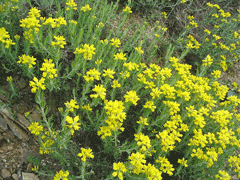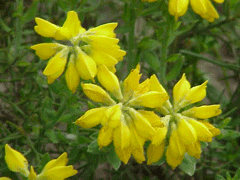 |
|
http://commons.wikimedia.org/wiki/User:Jeantosti |
 |
| biolib.de |
Translate this page:
Summary
Physical Characteristics

 Genista hispanica is a deciduous Shrub growing to 0.8 m (2ft 7in) by 1.5 m (5ft).
Genista hispanica is a deciduous Shrub growing to 0.8 m (2ft 7in) by 1.5 m (5ft).
See above for USDA hardiness. It is hardy to UK zone 6. It is in flower from April to May. The species is hermaphrodite (has both male and female organs) and is pollinated by Bees.
It can fix Nitrogen.
Suitable for: light (sandy) and medium (loamy) soils, prefers well-drained soil and can grow in nutritionally poor soil. Suitable pH: mildly acid, neutral and basic (mildly alkaline) soils. It cannot grow in the shade. It prefers dry or moist soil and can tolerate drought.
UK Hardiness Map
US Hardiness Map
Synonyms
Plant Habitats
Woodland Garden Sunny Edge; Ground Cover; Hedge;
Edible Uses
References More on Edible Uses
Medicinal Uses
Plants For A Future can not take any responsibility for any adverse effects from the use of plants. Always seek advice from a professional before using a plant medicinally.
Diuretic
The flowers have been used in the treatment of dropsy[4].
References More on Medicinal Uses
The Bookshop: Edible Plant Books
Our Latest books on Perennial Plants For Food Forests and Permaculture Gardens in paperback or digital formats.

Edible Tropical Plants
Food Forest Plants for Hotter Conditions: 250+ Plants For Tropical Food Forests & Permaculture Gardens.
More

Edible Temperate Plants
Plants for Your Food Forest: 500 Plants for Temperate Food Forests & Permaculture Gardens.
More

More Books
PFAF have eight books available in paperback and digital formats. Browse the shop for more information.
Shop Now
Other Uses
Hedge Hedge
Plants can be grown as a low hedge[29]. A good ground cover for sunny positions[190]. Plants take about 2 years to form an effective cover[197]. They should be spaced about 60cm apart each way and can be pruned back hard if they become open or straggly with age[208].
Special Uses
Ground cover Hedge Hedge Nitrogen Fixer Scented Plants
References More on Other Uses
Cultivation details
Easily grown in a light well-drained soil in a sunny position[1]. Prefers a rather dry stony or sandy soil and does better in one on the poor side[11]. Established plants are drought tolerant[190]. Plants are hardy to about -20°c[184]. Resents root disturbance and should be planted into its permanent position whilst small[11]. A very ornamental plant[1], it grows well on the top of walls and on hot dry banks, covering them with a dense mass of prickly greenery[182]. The flowers have a sweet refreshing perfume, like ripe apples or pineapples[245]. Plants occasionally die back in the centre of the clump, especially after cold wet winters. Cut out the dead growth and layer living shoots into the gap[200]. Closely related to G. tournefortii. This species has a symbiotic relationship with certain soil bacteria, these bacteria form nodules on the roots and fix atmospheric nitrogen. Some of this nitrogen is utilized by the growing plant but some can also be used by other plants growing nearby[200].
References Carbon Farming Information and Carbon Sequestration Information
Temperature Converter
Type a value in the Celsius field to convert the value to Fahrenheit:
Fahrenheit:
The PFAF Bookshop
Plants For A Future have a number of books available in paperback and digital form. Book titles include Edible Plants, Edible Perennials, Edible Trees,Edible Shrubs, Woodland Gardening, and Temperate Food Forest Plants. Our new book is Food Forest Plants For Hotter Conditions (Tropical and Sub-Tropical).
Shop Now
Plant Propagation
The seed requires a period of cold stratification and is best sown autumn in a cold frame. Pre-soak stored seed for 24 hours in warm water and sow February in a cold frame. Good germination[78]. When they are large enough to handle, prick the seedlings out into individual pots and plant them out in the summer. Cuttings of half-ripe wood, 5 - 10 cm with a heel, July/August in a frame. Roots are formed in the spring[11]. Cuttings of ripe wood, 5 - 10 cm with a heel, September/October in a frame. Good percentage. Plant out the following autumn[78].
Other Names
If available other names are mentioned here
Native Range
EUROPE: Spain, France (south)
Weed Potential
Right plant wrong place. We are currently updating this section.
Please note that a plant may be invasive in one area but may not in your area so it's worth checking.
Conservation Status
IUCN Red List of Threatened Plants Status :

Growth: S = slow M = medium F = fast. Soil: L = light (sandy) M = medium H = heavy (clay). pH: A = acid N = neutral B = basic (alkaline). Shade: F = full shade S = semi-shade N = no shade. Moisture: D = dry M = Moist We = wet Wa = water.
Now available:
Food Forest Plants for Mediterranean Conditions
350+ Perennial Plants For Mediterranean and Drier Food Forests and Permaculture Gardens.
[Paperback and eBook]
This is the third in Plants For A Future's series of plant guides for food forests tailored to
specific climate zones. Following volumes on temperate and tropical ecosystems, this book focuses
on species suited to Mediterranean conditions—regions with hot, dry summers and cool, wet winters,
often facing the added challenge of climate change.
Read More
Expert comment
Author
L.
Botanical References
1150200
Links / References
For a list of references used on this page please go here
Readers comment
| Add a comment |
|
If you have important information about this plant that may help other users please add a comment or link below. Only comments or links that are felt to be directly relevant to a plant will be included. If you think a comment/link or information contained on this page is inaccurate or misleading we would welcome your feedback at [email protected]. If you have questions about a plant please use the Forum on this website as we do not have the resources to answer questions ourselves.
* Please note: the comments by website users are not necessarily those held by PFAF and may give misleading or inaccurate information.
To leave a comment please Register or login here All comments need to be approved so will not appear immediately.
|
Subject : Genista hispanica
|
|
|
|